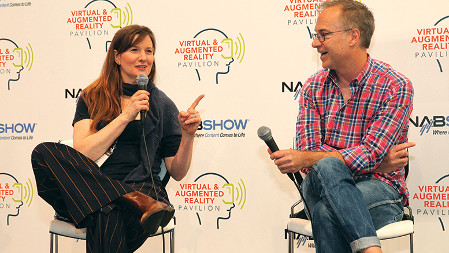Learning From Virtual Reality Failures
LAS VEGAS—The Virtual and Augmented Reality Pavilion in the North Hall has been a packed space since exhibits opened Monday. It’s an exciting time for those who are dabbling with or have jumped in head first to publishing immersive 360-degree product.
Working in virtual reality (VR) is not for the timid. To paraphrase former Defense Secretary Donald Rumsfeld, there are known unknowns, and there are unknown unknowns to VR.

From left: Julina Tatlock, co-founder of 30 Ninjas, and Matt Apfel, director, VR Video at Google
A packed Tuesday session “Google at NAB Show: VR Video — Building a Better Mousetrap for Creators” set out to help those starting in VR to learn from others’ experiences.
“We failed a huge amount of times,” said Julina Tatlock, co-founder of 30 Ninjas. She said her team actually measures how much they’re learning by how many times they fail. There were two different general areas of failure discussed during the panel: technical failure and artistic failure.
For those with little or no exposure to producing VR, there are the usual production steps of planning and/or scripting the shoot: the actual shoot, editing and finishing. Then there’s a tricky little step between acquisition and editing called “stitching.”
Stitching in VR is the process of seamlessly combining video from multiple cameras with slightly overlapping fields of view into a 360-degree panorama. A viewer wearing head-mounted goggles can then look at the video in any direction. Matching the cameras and the stitching software gradually has gotten easier. There were and are other technical problems.
Panel moderator Matt Apfel, director of VR Video at Google, noted that it used to take engineers with technical skills at a Ph.D. level to solve the issues of VR production. “That has been reduced down to maybe an undergraduate level of technical skill,” he said.
“The best part of experience was tech and story,” Apfel said. “Storytellers were telling engineers what they needed and taking advice from engineers on how to shoot those shots.”
He said it’s been helpful in educating the engineers on what kind of tools need to be developed to simplify the process. “You have to have a team that’s both creative and technical,” said Tatlock. Tech problems aren’t the only things that have to be worked out in VR production.
There are also artistic decisions. As an example, in a normal motion picture or television program, the audience doesn’t have the option of turning to look behind them. “We shot, edited, tested, saw what works and then went back and shot again,” she said.
In the motion picture and television fare most of us are used to, editors have well-established techniques for guiding the viewer through the story. VR provides some new challenges. Tatlock said they were initially afraid that cutting between 360-degree scenes might disrupt the optical flow for the viewer. “However, many things that we thought would break the optical flow actually didn’t.”
VR productions can be separated into two different types, post-produced and live. Apfel said that while live productions don’t provide the opportunity to be saved in post-production, the audience’s expectations for a live production generally are lower.
Sessions at the VR Pavilion continue through Thursday.
Copyright NAB 2017.
Get the TV Tech Newsletter
The professional video industry's #1 source for news, trends and product and tech information. Sign up below.
